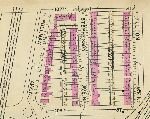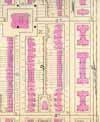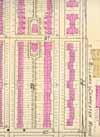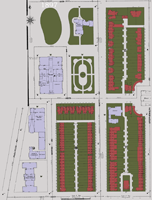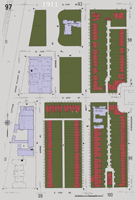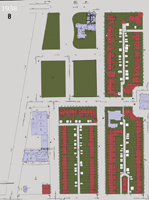Maps of Pullman
You are at Home -> The People -> Maps of Pullman1882 Hyde Park Township Maps
One of the most beautiful maps of Pullman, the 1882 Hyde Park Township plat map was hand colored. Mr. Pullman would not allow the map makers onto "his" property, so they were forced to guess at where things were located using drawings and photographs. Notice on the southern map, there is an older development (pre-Pullman) platted.

The northern half |

The southern half |
1886 Rascher Maps
Charles Rascher was a German surveyor who immigrated to Chicago sometime after 1871. He first established a surveying business after the 1871 Chicago Fire. By the 1880's he had developed his surveying company into a map making company and published maps of the developing city. Rascher's Map of Chicago and other parts of the Midwest were published between 1880 and 1892 (from the Edgewater Historical Society).Street Name Changes
Pullman's avenues were originally named after inventors. The street names were to have changed in 1907, when the city of Chicago annexed Pullman; however, many of the old names were still in use up until the 1930s. Corliss Avenue is named after the inventor of the "Corliss Engine", George Henry Corliss (1817-1888). The Corliss Steam Engine originally powered the Pullman works and provided steam heat for the public buildings in the town. Maryland Avenue is named for the state of Maryland. The state, in turn, is named the wife of King Charles I, Henrietta Maria. Charles was king at the time of the founding of the province in 1634. Maryland was originally named Ericsson Avenue (spelling varied on different maps). Ericsson is named after John Ericsson (1803-1889), inventor and engineer. He would have captured Mr. Pullman's attention because he developed and built the first ironclad, the U.S.S. Monitor which famously saw action in the American Civil War. Doty Avenue honors Duane Doty, original Pullman town manager. A street that no longer exists in North Pullman was Bessemer Avenue, named after Henry Bessemer (1813-1898), the inventor of a revolutionary method of making steel. His system is still in use today. Langley Avenue was probably named for Esther Langley, a relative of real estate developer, entrepeneur, and manufacturer Sivert Tobias Gunderson. Langley was originally Fulton Avenue, named for Robert Fulton (1765-1815). Fulton was an American engineer and inventor who developed the first commercially viable steamboat. Champlain honors Samuel De Champlain (1567-1635), French explorer and navigator who founded the city of Quebec. Champlain was originally Stephenson Avenue, named for George Stephenson (1781-1848). Stephenson Avenue occupied pride of place in the center spine of the town because the man the avenue honors built the first public railway line. All railways today are descended from this first railway; he also developed the standard gauge of railways (1440 mm, 4 feet 8 and half inches) still in use today. St. Lawrence Avenue is named after the St. Lawrence River, which connects the great lakes to the Atlantic Ocean. St. Lawrence is named, in turn, after the early Christian Martyr St. Lawrence (225-258 AD), deacon of Rome. He was killed in the persecution of Christians by Emporer Valerian by roasting him to death over an open grate. Before 1907, St. Lawrence was Watt Avenue. James Watt (1736-1819) invented, among many other things, the first modern and efficient steam engine. Forrestville was a small town on the south side in the 1850s. It was located near Hyde Park. The street name honors this now vanished town. Forrestville was originally named Morse, named for Samuel Morse (1791-1872), developer of the single wire telegraph system and famously the Morse code. Cottage Grove has a long history. Charles Cleaver (1814-1893) developed a suburb south of Chicago on the Illinois Central line called Cleaverville in the 1850s. Cleaverville eventually became the Oakland neighborhood north and west of Hyde Park. Cleaver named the street after a grove of shady trees that surrounded a cottage in his development. The grove was a popular meeting spot for early settlers.THE PULLMAN HISTORY SITE

The Sanborn Fire Insurance Maps
The Sanborn Company began making fire insurance maps in 1867 when founded by Daniel Alfred Sanborn, a surveyor from Somerville, Massachusetts. The Sanborn Map Company created maps for fire insurance assessment in the U.S. and within several decades became the largest and most successful American map company. (from Wikipedia)
The online Sanborn maps seen here are from 1897, 1911, and 1938. We have "hand colored" in the maps to provide more detail and context; structures in brick red are private residences, and structures in violet are commercial, Pullman Company, or public buildings.Other Pullman-Related Sites
- Historic Pullman Garden Club - An all-volunteer group that are the current stewards of many of the public green spaces in Pullman. (http://www.hpgc.org/
- Historic Pullman Foundation - The HPF is a non-profit organization whose mission is to "facilitate the preservation and restoration of original structures within the Town of Pullman and to promote public awareness of the significance of Pullman as one of the nation's first planned industrial communities, now a designated City of Chicago, State of Illinois and National landmark district." (http://www.pullmanil.org/)
- The National A. Philip Randolph Pullman Porter Museum is a 501(c)3 cultural institution. Its purpose is to honor, preserving present and interpreting the legacy of A. Philip Randolph, Pullman Porters, the Brotherhood of Sleeping Car Porters and the contributions made by African-Americans to America's labor movement. ((http://www.nationalpullmanportermuseum.com/)
- Pullman Civic Organization - The PCO is a strong and vibrant Community Organization that has been in existence since 1960. (http://www.pullmancivic.org/)
- Pullman National Monument - The official page of the Pullman National Park. (https://www.nps.gov/pull/)
- South Suburban Genealogical & Historical Society - SSG&HS holds the Pullman Collection, consisting of personnel records from Pullman Car Works circa 1900-1949. There are approximately 200,000 individuals represented in the collection. (https://ssghs.org/)
- The Industrial Heritage Archives of Chicago's Calumet Region is an online museum of images that commemorates and celebrates the historic industries and workers of the region, made possible by a Library Services and Technology Act grant administered by the Illinois State Library. (http://www.pullman-museum.org/ihaccr/)
- Illinois Digital Archives (IDA) is a repository for the digital collections libraries and cultural institutions in the State of Illinois and the hosting service for the online images on this site. (http://www.idaillinois.org/)


